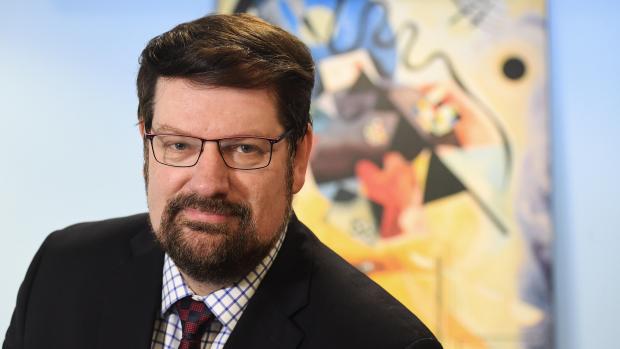Introducing the new chair of Tandon’s Department of Biomedical Engineering
Meet Andreas Hielscher

Professor Andreas Hielscher Photo credit: Eileen M. Barroso
Professor Andreas Hielscher arrives at NYU Tandon with extensive research and teaching experience — and a strong historical connection to the school.
“About 20 years ago, I completed a fellowship at the Los Alamos National Laboratory, where I investigated new ways of modelling light propagation in biological tissues, a burgeoning field at that time,” he recalls. “When I was subsequently invited to work at the State University of New York (SUNY) medical school, I saw it as a great opportunity to apply this theoretical knowledge to real clinical problems. At the same time, I needed engineering students for my group. Brooklyn Poly, the precursor to Tandon, was the obvious place to look. We launched a new joint program with the help of SUNY’s Randall Barbour and Yao Wang, who is now Tandon’s Associate Dean for Faculty Affairs, and I was appointed one of its first professors.”
Hielscher never got the chance to deepen that connection, however. After he had secured his first National Institutes of Health (NIH) grant, he was recruited by Columbia University, which had just opened a biomedical engineering department. He remained at Columbia until this year but is now excited to return to his career roots in Brooklyn, to continue where he started two decades ago.
As the new chair of Tandon’s Department of Biomedical Engineering, Hielscher has big plans. There are new faculty members to hire, Ph.D. and undergraduate programs to get off the ground, and partnerships to forge with NYU Grossman School of Medicine and NYU Langone Medical Center. “Building on Mary Cowman’s work to establish the department, and leveraging the excellence of the medical expertise at NYU, we should become one of the premier Departments of Biomedical Engineering in the country,” he says.
He is also very enthusiastic about the opportunities for international collaboration that NYU presents with schools, for example, in Abu Dhabi and Shanghai. Hielscher has long been interested in strengthening the bonds between physicians and engineers on a global scale. “With partners from Jordan (including a former NYU Tandon graduate, Prof. Rabah Al Abdi) we have established a Mideast Limb Salvage Consortium,” he says. “Our goal is to develop new technologies and methods to address the fast-growing problem of diabetes and its related diseases in the region.”
That’s just one facet of his own research, which has been continually funded by the National Institutes of Health ever since that first long-ago grant. Hielscher, who will oversee his own Clinical Biophotonics Laboratory at Tandon, focuses on developing new medical imaging technologies that use near-infrared light instead of more common X-rays or ultrasound. Light transmitted through the human body, he explains, can provide information about the blood and oxygen supply in various tissues, and that information can be used by clinicians to diagnose and monitor various diseases.

This series of 6 images shows cross sections of a breast with a tumor during a breath hold, taken with a dynamic optical tomographic breast imaging system (DOTBIS) developed by Dr. Hielscher, As a patient holds their breath, the blood concentration increases by up to 10% (seen in red). Dr. Hielscher’s team found that analyzing the increase and decrease in blood concentrations inside a tumor could help them determine which patients would respond to chemotherapy. (For details see J.E. Gunther, E. Lim, H.K. Kim, M. Flexman, J.A. Campbell, H. Hibshoosh, K. Crew, K. Kalinsky, D.L. Hershman, A.H. Hielscher, “Dynamic diffuse optical tomography for monitoring neoadjuvant chemotherapy in breast cancer patients,” Radiology 2018 Jun; 287(3):778-786.
The owner of several patents, he has applied biophotonic technology in multiple areas, including breast cancer, rheumatoid arthritis, and peripheral artery disease (PAD) in diabetic patients, and his work is often published in both engineering journals and those aimed at clinicians, such as Breast Cancer Research and Treatment, Pediatric Dermatology, and Radiology.
“The vast majority of my research is highly translational,” he says. “Almost all the projects my team undertakes involve major clinical studies with patients. We want our work to go quickly from lab bench to bedside, where it helps patients.” He concludes, “I’m eager to continue that trajectory at Tandon and to help educate biomedical engineers capable of innovation in disease diagnosis and patient treatment.”




